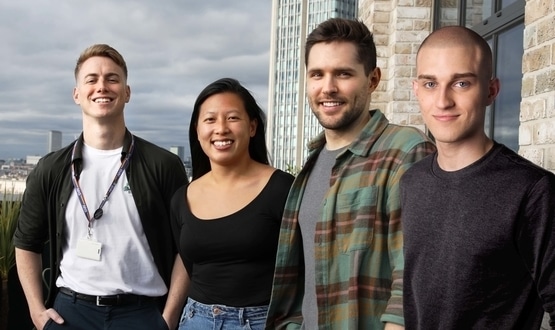QueerTech: Procuring with Pride
- 28 June 2021

As Pride Month comes to an end Brett Hatfield, an NHS Navigator for DigitalHealth.London, explores the term QueerTech and why technology needs to be inclusive for all.
QueerTech: it’s on the rise and it’s long overdue. While the term is new, I would loosely define it as inclusive technology designed to support the needs of the LGBT+ community. As the Covid-19 pandemic has forced thousands of NHS and social care services online, we need to view digital health through the rainbow lens to create more inclusive health and social care services for patients and staff. QueerTech and greater LGBT+ representation in the digital health space can generate open and inclusive conversations across the NHS and social care to further challenge homophobia and transphobia, and ultimately bridge the gap in service provision for the LGBT+ community. The time for QueerTech is now, and it has already begun.
Even in a digital age, the NHS digital health space is still establishing its identity. Too often digital health professionals are lumped in with IT or technical support. When I was starting my nursing career on the trauma ward in Australia, it was a field I barely understood. I certainly could not have imagined I would become a part of digital health and an advocate for it. My perception at the time was that, as a member of the queer community, I would not have been welcome in what is a fairly male-dominated industry. And although the stereotype that workplaces dominated by straight men are not the most accepting isn’t always true, myself and other LGBT+ professionals still often struggle with issues of heteronormativity and concerns around acceptance from others. My experience of working in the NHS digital health space has been very positive, but this is not the case for all LGBT+ colleagues – there is still much work to be done.
Why the term QueerTech?
Queer is a bit of an umbrella term within the LGBT+ community that carries different connotations for different people. While it has been used in a derogatory way in the past, by and large the term has been co-opted by the community as a term of positivity and acceptance, and it is in this spirit in which the term ‘QueerTech’ is intended.
Why QueerTech is needed
As society comes to terms with queer acceptance, more and more individuals are steering away from categorical heterosexuality and binary genders. Many may have heard that 1 in 10 people identify as gay, bisexual or lesbian. However, a 2015 YouGov poll suggested that this number may be much higher: when British people were asked to plot themselves on a ‘sexuality scale’, 23% chose something other than 100% heterosexual – and the figure rises to 49% among 18-24 year-olds. Approximately 1 in 100 people identify as trans or non-binary, although data on the subject is limited. Around 1.7% of the population is born with intersex traits – comparable to the proportion of people born with red hair. The numbers are clear: queer individuals are among us and in the masses. But it still doesn’t address the question: why would we need queer-friendly technology in healthcare? The justification behind QueerTech stems from a deep-rooted homophobia and transphobia that still exists within healthcare. Stonewall’s Unhealthy Attitudes (2018) report on LGBT+ experiences in healthcare demonstrated that one in four LGBT+ people said they have experienced a lack of understanding of specific lesbian, gay and bi health needs by healthcare staff (the proportion is even higher for trans people: three in five). Two in five trans people and 7% of LGB people said they have experienced difficulty accessing healthcare because they are LGBT+. This number rises to one in five for those with a disability, and the same figure holds for Black, Asian and minority ethnic LGBT+ people.
At the age of 17 when I was figuring out my sexuality, I recall seeing a psychologist who asked me how I could possibly know that I’m gay when I had never physically been with a woman – I felt very uncomfortable with this suggestion and so tried to access support elsewhere. I eventually came to terms with my sexuality, but it took some time before I eventually felt comfortable disclosing my same-sex attraction to health professionals once again.
Action must be taken to avoid this strain of systemic homophobia and transphobia that exists within healthcare from bleeding into the technology developed by commissioners and providers. For example, online consultations were rolled out en masse towards the beginning of the COVID-19 pandemic so that patients could request treatment by their GP practice online. This has had the welcome benefit of increased signposting to alternative services. However, a Sussex Healthwatch report on patient preferences for digital services demonstrated that lesbian, gay and bisexual patients were more likely to delay their appointments, and were significantly less satisfied with online services compared to their heterosexual counterparts. One of the reasons is because LGBT+ patients did not know which GP at their practice might review their online form with intimate details about their health, and feared having an online consultation with a GP that was not supportive of LGBT+ needs. Fears from LGBT+ patients of misgendering, judgement on lifestyle choices, or inappropriate curiosity lead to a lower inclination to seek medical help and thus poorer health outcomes. We need to do better in developing and procuring inclusive health technology for the NHS.
QueerTech in Practice
We are seeing QueerTech emerge in various industries to help improve the lives of LGBT+ individuals. Kalda are developing a smartphone app designed to be a safe space for LGBT+ people with a focus on mental health. Their evidence-based online platform provides users with access to daily peer support and weekly group therapy sessions, all of which are inclusive to LGBT+ needs. What better time than now – as the pandemic has seen NHS waiting times for mental health support and specialist care lengthen enormously – for inclusive health technology that LGBT+ individuals can access in the palm of their hands.
QueerTech also need not be technology that exclusively caters to the LGBT+ community. It can simply represent options inclusive of the community, including gender neutral language, options for non-binary pronouns, recognition of same-sex relationships, and diverse representation in advertising and messaging. Peppy Health, a company on the DigitalHealth.London Accelerator programme that provides specialist healthcare and wellbeing support, is a prime example of technology that incorporates the needs of the LGBT+ community. For example, Peppy emphasises that their menopause support programme is available to all people, acknowledging that their products are not just for women, but transmen and non-binary individuals with ovaries as well.
Tips for Digital Health Commissioners
LGBT-inclusive or LGBT-specific technology such as Kalda and Peppy Health are compelling examples of how we should be designing technology in healthcare. It’s time to queer the tech ecosystem through more LGBT+ representation and inclusive technology designed to support the needs of the LGBT+ community. Here are a few tips on how to ensure the solutions you procure are LGBT-inclusive:
- Explicit messaging is essential. Terms such as “we provide an inclusive service” are vague and can be interpreted in different ways when promoting your solution to patients. LGBT+ individuals are often familiar with services and communities who claim to be supportive but have let them down, and these mixed messages have stuck with us. Please, be explicit because it really does help.
- Use gender-neutral language. Remember, transwomen and non-binary individuals may benefit from men’s health services, and vice versa. Not only does gender-neutral language help to break away from the gender binary, but it also ensures the technology that you procure does not discriminate against trans and non-binary people who may use your digital services.
- Have diverse representation when promoting digital health. NHS organisations that exclusively promote images of nuclear families and binary genders can imply that that is your target audience for a digital health service. This ties into the first point – explicit messaging is key to ensure you cater to a diverse crowd.
- Options for non-binary pronouns. Technology should provide endless options, but often we see checkboxes or dropdown menus that are binary and limiting. Service specifications for procuring digital solutions should require that solutions offer more choice in this area – it’s a simple way to be more inclusive.
- Monitor gender and sexual orientation. It’s important to keep track of demographics to ensure you are reaching LGBT+ people effectively.
- Equality and Health Inequality Impact Assessments (EHIA). EHIAs should be a core component of all digital transformation work. It’s essential that you work alongside your organisation’s Equality and Diversity Lead to ensure these assessments are thorough and actioned upon.
- Ask the community, they want to hear from you. If you’re not sure, then ask. LGBT+ groups want services to meet their needs. Engagement with vulnerable groups should be a core focus of any digital transformation project and should begin as soon as possible to ensure your solution meets the needs of LGBT+ people and other groups.
- Need more advice? Contact the LGBT Health advisor at NHS England. The National Advisor for LGBT Health (England.lgbtadvisor@nhs.net) is there to work with relevant statutory organisations and professional associations to embed LGBT needs into NHS services.
If you would like to know more about QueerTech or share how your company is developing LGBT-inclusive technology, please get in touch with DigitalHealth.London at brett.hatfield@nhs.net.


